 |
 State of Maryland leaders will join University System of Maryland (USM) Chancellor Jay A. Perman at 1 p.m. Friday, Oct. 15 to celebrate the unveiling of the Academic & Innovation Center for the University System of Maryland (USM) at Southern Maryland (USMSM) in California, MD. State of Maryland leaders will join University System of Maryland (USM) Chancellor Jay A. Perman at 1 p.m. Friday, Oct. 15 to celebrate the unveiling of the Academic & Innovation Center for the University System of Maryland (USM) at Southern Maryland (USMSM) in California, MD.
The new Southern Maryland Autonomous Research and Technology (SMART) building is an $86 million, 84,000-square foot academic and research facility that will nearly double the educational footprint of USMSM, create autonomous systems research space, and spur economic activity and job growth.
Several Maryland leaders and their representatives will join USM Chancellor Jay A. Perman for the unveiling. They include Maryland House of Delegates Speaker Adrienne Jones; University of Maryland, College Park (UMCP) President Darryll Pines; Maryland state senators Arthur Ellis, Jack Bailey, and Melony Griffith; Maryland Del. Brian Crosby; representatives from the offices of Gov. Larry Hogan, U.S. Sen. Chris Van Hollen, and U.S. Sen. Ben Cardin; and James Randy Guy, the Commissioner and President of the Commissioners of St. Mary’s County. Members of the USMSM Board of Advisors also will be present.
UMCP; Bowie State University; Salisbury University; Towson University; and University of Maryland Global Campus (UMGC). Programs are offered in high-demand areas such as computer science, business administration, criminal justice, education, engineering, nursing, and social work.
Additionally, other educational partners such as Notre Dame of Maryland University and Florida Tech University sponsor degree and certificate programs. USMSM also facilitates the advancement and growth of the Naval Air Station at Patuxent River, as well as defense contractors and the local community, through its extensive conference and training.
 “The SMART Building is distinctive for being so important to two missions—on the academic side, allowing us to educate more Southern Maryland students, and on the research side, giving us the kind of state-of-the art space USMSM needs to pioneer unmanned systems technology,” said USM Chancellor Perman. “I can’t wait to join System colleagues and state leaders for this exciting event, ushering in a new age of education and innovation in a region that’s got so much to contribute to Maryland.” “The SMART Building is distinctive for being so important to two missions—on the academic side, allowing us to educate more Southern Maryland students, and on the research side, giving us the kind of state-of-the art space USMSM needs to pioneer unmanned systems technology,” said USM Chancellor Perman. “I can’t wait to join System colleagues and state leaders for this exciting event, ushering in a new age of education and innovation in a region that’s got so much to contribute to Maryland.”
The academic half of the new SMART Building will nearly double the educational footprint of USMSM. In the new state-of-the-art classrooms, students from across the Southern Maryland region will have enhanced access to in-demand educational programs, giving these students the opportunity to live, work, and study close to home.
The innovation half of the SMART Building features a massive Unmanned Autonomous Systems (UAS) research facility, which will include sea, air, and land capabilities. The facility will make the University System of Maryland at Southern Maryland the USM’s only regional higher education center with a research component.
Construction on the new center began in Fall 2019.
The new facility is also expected to be a catalyst for economic activity and job growth in the region. St. Mary’s County is home to several important economic assets—including the St. Mary’s County Regional Airport and Naval Air Station Patuxent River—as well as defense contractors, tech companies, and the business technology incubator, TechPort, which all combine to create a burgeoning “Innovation District” fostering an emerging research-and-development economy in Southern Maryland.
Established 20 years ago, the concept of the USM regional centers is unique nationally. These are not “satellite” campuses of a single university, but rather conveniently and strategically located sites where multiple universities deliver their most in-demand undergraduate, graduate, professional degree, and certificate programs. The regional centers are full-service extensions of the USM that respond to meet the educational needs of students and workforce needs of employers and that are—above all—an affordable alternative to traditional 4-year pathways.
The USM regional centers offer degree programs through partner universities that allow students the opportunity to live, work, and study close to home. As the USM’s third regional center, USMSM will build on previous efforts to ensure that students in areas of the state not located near a public university can access programs offered by the 12 institutions in Maryland’s state higher education system. The USM’s other regional centers are USM Hagerstown (USMH) and the Universities at Shady Grove (USG).
The SMART Innovation Center will offer the high-bay space of 20 foot ceilings required to test unmanned aircraft. The research conducted at USMSM will take place in tandem with testing programs conducted by the U.S. Navy at Naval Air Station Patuxent River. USMSM estimates that, within eight to ten years, research revenues from this collaboration could range from $3 million to $5 million per year.
The USM comprises 12 institutions: Bowie State University; Coppin State University; Frostburg State University; Salisbury University; Towson University; the University of Baltimore; the University of Maryland, Baltimore; the University of Maryland, Baltimore County; the University of Maryland Center for Environmental Science; the University of Maryland, College Park; the University of Maryland Eastern Shore; and the University of Maryland Global Campus. The USM also includes three regional centers—the Universities at Shady Grove, the University System of Maryland at Hagerstown, and the University System of Maryland at Southern Maryland—at which USM universities offer upper-division undergraduate and graduate courses.
Systemwide, student enrollment is 170,000. The USM and its institutions compete successfully nearly $1.5 billion in external grants and contracts annually. USM institutions and programs are among the nation's best in quality and value according to several national rankings. To learn more about the University System of Maryland, visit www.usmd.edu.
Related Articles:
Baras, Sadler part of large ARL DataDrivER project
New algorithms for multi-robot systems in low communication situations
ArtIAMAS receives third-year funding of up to $15.1M
Helping robots navigate to a target, around obstacles and without a map
'MorphEyes' stereo camera system improves quadrotor UAV navigation
UMD Opens Outdoor Flight Laboratory to Advance Autonomy, Robotics
Developing Efficient Systems for Deep Sea Exploration
Alum Fumin Zhang elected to IEEE Fellow
Diving Deeper into Competition, and Recruitment
UMD Student Team Lauded for Award-Winning Drone
October 13, 2021
|

